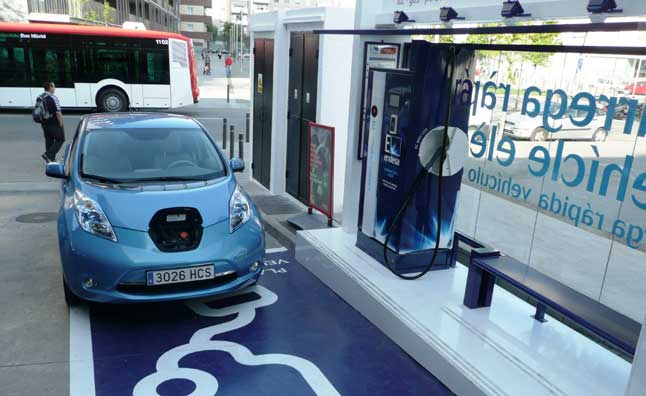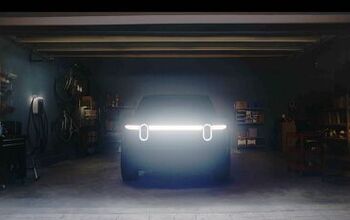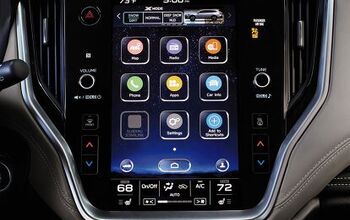The Power of the Gas Pump, By the Numbers
It doesn’t take much to spark a conversation with an electric car advocate.
A casual comment about the drawbacks of an EV—doesn’t it take a long time to recharge?—will quickly spin into passionate arguments about efficiency, kilowatt-hours, and states of charge. Electric car detractors are no less vociferous about the superiority of petro-power. Why do folks from both sides of the argument usually fail to win new converts? Because laypeople are clueless about even the most basic technical terms that underpin the discussion. So here comes my attempt to translate EV geek-speak into English.
If you tried to get the same amount of energy from a household outlet as you get from a gasoline pump, it would take about nine days. Of course, it doesn’t take nine days to recharge an EV, because the efficiency of an EV allows the driver to put less energy in the “tank” and still receive an adequate charge. Photo: The electric fuel plug of the Tesla Roadster.
Power to the People
The first important issue to address is the fundamental difference between energy and power. There’s a difference? There is—and if you can’t readily tell the difference between the two, don’t feel bad. Experts, officials and the media frequently confuse these terms. The difference between energy and power is quite simple:
- Energy is the ability to do work
- Power is the rate at which work is done
Understanding the difference is very important to the overall understanding of electricity and electrical systems, including electric cars and hybrid vehicles. The amount of energy in your batteries (or in your gas tank, for that matter) indicates the distance you can travel before refueling. That’s known as range, and it’s perhaps the most important issue involved in getting more electric cars on the road. The power rating of your electric motor (or gas engine) tells you how quickly you can turn that energy into useful work, such as vehicle acceleration.
To make this more useful in comparing gas-engine cars and electric vehicles, we need to introduce two more terms:
- kilowatt (a measure of power, abbreviated kW)
- kilowatt-hour (a measure of energy, abbreviated kW-hr or kWh)
Let’s begin by flipping on a 100-watt light bulb—better yet, make that 10 of those 100-watt light bulbs. With all 10 bulbs illuminated, you are burning 1 kilowatt of power. Leave those lights on for an hour, and you will have used 1 kilowatt-hour of energy. Get it?
In general terms, that same amount of energy—1 kilowatt-hour—will move an electric car about four miles down the road. The amount of electric fuel that an EV driver can store in batteries depends on a lot of factors: the number and size/shape of batteries, and how willing you are to fully charge and discharge those batteries (thus affecting how long the batteries last). Those are all energy issues. The power issues, on the other hand, are more circumscribed: recharging your batteries from a common household outlet occurs at 1.5 kilowatts. Without getting into complicated math, just know that 1.5 kilowatts is a relatively small power spigot and it’s going to take the driver of an EV a good few of hours, if not seven or eight, to recharge batteries capable of a couple hundred miles of driving. (To be more specific: At 4 miles range per kWh, one can charge from an ordinary wall outlet at a rate of —at most—6 miles of added range per hour of charging, or “6 mph.” Then there is the taper-off toward the end of charge, making the last 10-20% of charge even longer).
On the other hand, an internal combustion engine stores its energy in the form of gasoline—and gas packs a 33-kilowatt-hour punch in every gallon. There’s a lot of juice in that juice. Unfortunately, the tank-to-wheels efficiency of the gas engine is five or six times less than that of an electric motor’s battery-to-wheels efficiency. If you consider what it took to extract the petroleum from the well, transport it to a refinery in supertankers and big rigs (both of which are also burning fossil fuels), and then inefficiently burn it in internal combustion engines, then the wastefulness looks even more extreme. (And that’s without calculating the geopolitical and environmental effects of that oil supply chain.)
But for the moment, I’m not concerned about efficiency or sea otters. I need to get to work, my car is running nearly empty, and I need to quickly fill up on those “33 kilowatt-hour” gallons—or my boss will not be happy. Let’s assume that my car’s gasoline tank is 10 gallons. In the five minutes it took to fill up, I would have placed 330 kilowatt-hours of energy in my tank.
If I tried to get the same amount of energy from a household outlet, it would take me about nine days. Of course, it doesn’t take nine days to recharge an EV, because the efficiency of an EV allows the driver to put less energy in the “tank” and still receive an adequate charge. But the comparison shows how gasoline became such a popular fuel over the past century: it allows us to put a lot of energy in our cars very quickly. For the sake of comparing refueling times of gas and electric cars, we need to look at power—again the rate of transferring energy or, in this case, refueling. So, in power terms, I refuel my gas-powered car at 10 gallons per five minutes or 120 gallons per hour. Those 120 gallons—at 33 kilowatt-hours in a gallon—put 3,960 kilowatt-hours in my tank.
If I haven’t lost you entirely, we can at last calculate the power of the gas pump:
- 3,960 kilowatt-hours per hour, or 3,960 kilowatts
If I did lose you, that’s OK. We have the numbers necessary to compare the power of the gas pump versus the power of the electric cord.
- The power of the gas pump is 3,960 kilowatts
- The power of the electric cord is 1.5 kilowatts
- The gas pump is 2,640 times more powerful than the electric cord
Yes, I’ve disregarded the greater efficiency of the EV versus the gas engine when the fuel is used. But you get the point.
The next equation to consider is cost, but it doesn’t involve another math lesson. The more important equation is not fundamentally mathematical: are we willing forgo the five-minute fill-up in exchange for the overnight recharge if it helps us break the 100-year-old dominance of the internal combustion engine, and avert future oil price shocks, oil wars, and global warming? That’s your homework assignment.
Become an AutoGuide insider. Get the latest from the automotive world first by subscribing to our newsletter here.
More by AutoGuide.com Staff
































Comments
Join the conversation